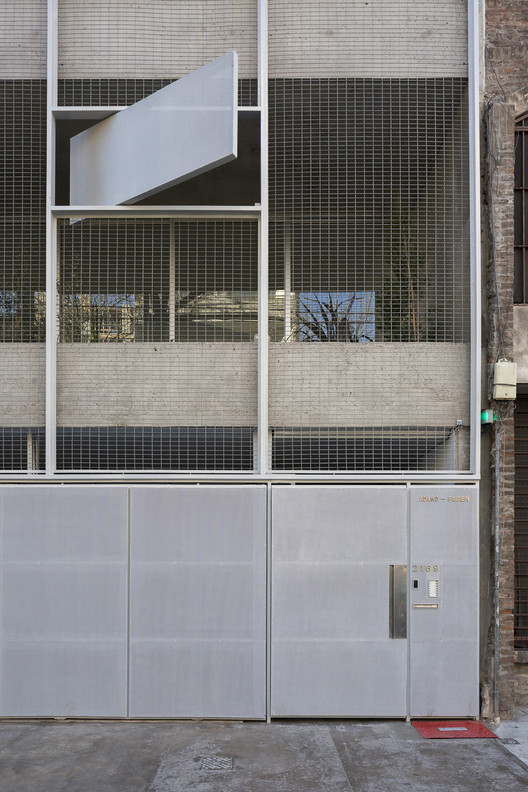170 Amsterdam Handel Architects
2015-06-16 11:00
© Bruce Damonte
布鲁斯·达蒙特


架构师提供的文本描述。我们的客户想要一个解决方案,使曼哈顿上西区一处狭长的场地的面积最大化。他们不想要一座全玻璃建筑,但希望在不影响能源效率的情况下利用大窗户的好处。
Text description provided by the architects. Our client wanted a solution that maximized floor area on a long narrow site on the Upper West Side of Manhattan. They did not want an all glass building, but wanted the benefits of large windows without compromising energy efficiency.
© Bruce Damonte
布鲁斯·达蒙特


创建一个新的终点站为W68街,170号阿姆斯特丹位于中央公园之间的东部和景观的开放空间林肯大厦的超级大厦在西方。建筑的建筑和外骨骼定义了外部是从它的位置,这些大的绿色空间和它的直接背景。该结构的交叉口以不同的高度上升到建筑物的顶部,使之看起来像一个正在运动的立面,同时也允许将预制的玻璃纤维模板与混凝土循环一起重复使用。把结构移到外壳外面,释放出有价值的室内空间,这些空间本来会被柱子占据,而突出的石板和柱子为整个玻璃外墙提供了一层面纱,并起到了遮阳装置的作用。深深的立面连接着阿姆斯特丹大街下、林肯中心、上西区和芝加哥标志性建筑的肌肉发达的建筑。在地面上,立柱创造了一个动态的街道墙,暴露的结构与人行道的角度,穿透建筑物的坚固形式的天篷。在顶部,建筑物的体积随着骨架的继续而结束,为屋顶空间创造了一个结构天篷。在内部,暴露的混凝土柱穿过建筑物的公共空间,穿过大厅、公共房间和走廊的地板和墙壁,然后消失在上面的天花板中。在公寓里,透过从地板到天花板的玻璃看到这座建筑的效果,就像悬挂在一间树屋里,被建筑物的外骨骼的树枝支撑着。
Creating a new terminus for W68th Street, 170 Amsterdam sits between Central Park to the east and the landscaped open space of the Lincoln Towers superblock to the west. The building’s architecture and the exoskeleton that defines the exterior is derived from its location between these large green spaces and its immediate context. The intersections of the structure rise to the top of the building at different heights, giving the appearance of a façade in motion while also allowing for the prefabricated fiberglass formwork to be reused with the concrete cycle. Moving the structure to the outside of the enclosure freed up valuable interior space that would have been occupied by columns and the projecting slabs and columns provide a veil over the all glass façade and act as a shading device. The deep façade of the diagrid connects with the muscular buildings of lower Amsterdam Avenue, Lincoln Center, the Upper West Side and iconic Chicago architecture. At ground level, the columns create a dynamic street wall, with the exposed structure angling into the sidewalk and piercing the solid form of the building canopy. At the top, the building’s volume ends while the skeleton continues, creating a structural canopy for the rooftop spaces. Inside, the exposed concrete columns angle through the public spaces of the building piercing the floors and walls of the lobby, common rooms and corridors, and disappearing into the ceiling above. In the apartments, seeing the structure through the floor-to-ceiling glass has the effect of being suspended in a treehouse, held up by the branches of the building’s exoskeleton.
© Bruce Damonte
布鲁斯·达蒙特


Structural Diagram


© Bruce Damonte
布鲁斯·达蒙特


用于制造外骨骼的混凝土是一种特殊的混合材料的结果,这种混合使材料看起来像石灰石,这是对林肯广场附近的建筑物的一种认可。为圆形,交叉柱形状的模板涉及一个复杂的玻璃纤维系统与多个单位是紧密连接在一起,以实现最大程度的再利用和经济。设计了成型系统和补强装置,使泵管插入到交叉形状中,表面光滑一致,无瑕疵和变色。采用小骨料配合比可以使混凝土在没有振动的情况下被放置在模板的盲区。混凝土配合比是一种密实、高流体的自固结混合料,采用灰水泥和矿渣进行轻灰处理,达到LEED标准。
The concrete used to create the exoskeleton is the result of a specialized mix that gives the material the appearance of limestone, a nod to the buildings in the Lincoln Square neighborhood. The formwork for the round, crossed column shapes involved an intricate fiberglass system with multiple units that were tightly connected together to achieve maximum reuse and economy. The form system and the reinforcing were designed so a pump-placing tube could be inserted into the crossed shapes, which achieved a smooth and consistent surface without blemishes or discoloration. Using a small aggregate mix enabled the concrete to be placed into the blind areas of the formwork with no vibration. The concrete mix was a dense, high fluid self-consolidating mix, using grey cement and slag to achieve a light grey finish and meet LEED standards.
© Bruce Damonte
布鲁斯·达蒙特


Plans and Sections
图则及分段


© Bruce Damonte
布鲁斯·达蒙特


































Architects Handel Architects
Location 170 Amsterdam Avenue, New York, NY 10023, United States
Category Commercial Architecture
Area 21235.0 sqm
Project Year 2015
Photographs Bruce Damonte
























